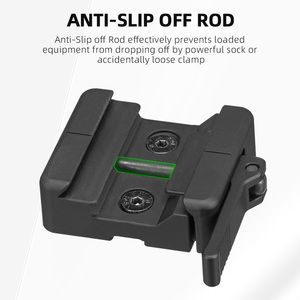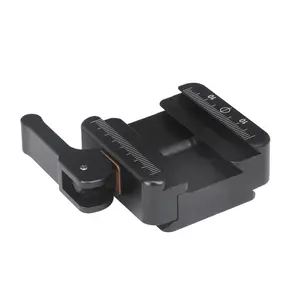(7564 products available)








































































































































































Picatinny rail to rail adapters come in several types, each serving a unique purpose and catering to specific needs. Here are the main types:
Standard Adapters
Standard Picatinny-to-Picatinny adapters are basic tools that permit the attachment of gadgets to rails that are spaced apart. These adapters have matching slots for the standard rail sections, which makes it easy to fix anything from scopes to lights across different rail lengths. Their simplicity and functionality make them the most commonly used adapter. Generally, they are used on firearms that have different rail configurations, thus allowing the mounting of accessories even when the standard mounting points are not available.
Low-Profile Adapters
Low-profile Picatinny rail to rail adapters are designed to minimize the height difference between the rail and the attached accessory. This close fit reduces the center of gravity of the mounted accessory and improves the overall steadiness of the aiming devices, especially for long-range shooting. Moreover, by lowering the accessory, the likelihood of interference with other parts of the firearm is reduced. This is more so in firearms with a low mounting space like shotguns or handguns with very low slides.
Offset Adapters
Offset Picatinny rail adapters are used to mount accessories to the side of the rail instead of directly above. This lateral spacing can be very important in applications that require quick access to two different accessories. For instance, one can have a scope for long-range targeting and a flashlight for short-range target acquisition, and they are both mounted on the same rail but at different offsets. This configuration is popular for tactical use where different aiming devices and accessories need to be accessed quickly and used simultaneously.
Swivel Adapters
Swivel adapters are designed to allow rotation of the mounted accessory through a limited range of motion. This provides flexibility in aiming and using the accessory without removing it from the rail. It is particularly useful for accessories such as grenade launchers or flashlights that may require different angles of use. The swivel mechanism gives an added advantage of adjusting the mounted gear according to the specific need while still being mounted on the firearm.
There are many applications of Picatinny rail to rail adapters. Below are some of them:
Firearms
In the gun industry, Picatinny rail to rail adapters are used in firearm setups. The adapters make it easy for gun enthusiasts to attach accessories such as scopes, flashlights, grips, and other tools. They also help in customization and improving the efficiency of firearms. For instance, a gun with an adapter can have multiple accessories, such as a flashlight and a red dot sight.
Ammunition
Similarly, Picatinny rail to rail adapters can be used in some firearm setups. The adapters help attach additional features to the ammunition, making them more effective. For instance, an adapter can attach a Picatinny rail to a cylindrical ammo case, making it easy to attach accessories.
Optics
In optics, there are many uses for Picatinny rail to rail adapters. They are mainly used to attach scopes and other optic devices to firearms. With the right adapter, one can attach different optic devices with varying mounting requirements to a firearm.
Vehicle
Rail adapters can also be used to attach accessories to vehicles. With the right adapter, one can easily attach tool racks, navigation devices, and other accessories. Also, the attachment makes it easy to transport the accessories, making them more effective.
Photography
Another common application of rail adapters is in photography. The adapters allow photographers to attach different rails and accessories to the camera. Also, with the right adapter, one can use different accessories on the same camera, which helps reduce costs.
Sports
There are also applications for rail adapters in sports. For instance, one can attach a Picatinny rail to a sports item, like a gun, and then use an adapter to attach another rail. This makes it easy to fix sports items, such as scopes, to the item, which is beneficial for some games.
Lighting
Lighting is another area where rail adapters can be used. With the proper adapter, one can attach different light rails to a fixture. This is particularly useful when using light rails, as one can easily attach different light fixtures and customize the lighting.
Selecting the correct Picatinny rail to rail adapter requires careful consideration of various factors to ensure compatibility, functionality, and overall performance. Here are some key aspects to keep in mind:
Flexibility
Picatinny to Picatinny rail adapter has a significant role in the mounting system; it enables the user to adapt the existing rail configurations to meet their needs better. With this, users can now mount devices that are not compatible with the current configuration of the rail. This ensures that every equipment needed for operation is mounted and securely held.
Safety
Another vital role of rail adapters is to ensure that the mounted equipment is secure. It minimizes the chances of equipment falling off or being misaligned during use, which can be dangerous. Therefore, it plays a crucial function in protecting the safety of the user.
Durability
Most of the rail adapters are made of high-quality materials like aluminum and steel. These materials can withstand the rigors of use and harsh conditions. Also, they are not affected by corrosion and can bear heavy loads.
Simple Installation
Most rail adapters are effortless because they come with all the necessary hardware for installation. In addition, they have user-friendly designs, which mean no special skills are required to install them.
Low profile
Most rail adapters have a low-profile design, which ensures that the equipment is not excessively raised. This design minimizes the center of gravity of the mounted equipment, which enhances stability. In addition, being low-profile makes aiming at the equipment easier, which reduces the chances of parallax errors.
Adjustability
Some adapters have adjustable positions. This allows the user to set the mounted equipment in the most suitable position that offers optimum functionality and convenience. The user can also set the equipment to free up space for other gear.
Standard Mil-Spec
Most adapters are designed to ensure compatibility with many mounting devices and rail specifications. This guarantees that the adapter can be used with the various equipment that requires mounting.
Locking Mechanism
Some adapters have added security features, such as locking mechanisms, to enhance the security of the mounted equipment. This feature is crucial, especially for equipment that experiences heavy use and recoil forces, as it prevents it from loosening or slipping off due to vibrations.
Q1: What is the purpose of a Picatinny rail to rail adapter?
A1: A Picatinny rail to rail adapter's primary function is to allow different types of rails to be connected, which makes it possible to attach accessories that wouldn't normally fit due to variations in size, spacing, or height. This enhances the adaptability of the weapon's rail system.
Q2: What materials are typically used in making Picatinny rail to rail adapters?
A2: Most Picatinny rail to rail adapters are made from either aluminum or high-quality polymer. Aluminum is lightweight, strong, and durable and can withstand harsh conditions. Polymer is also durable and lightweight but less strong than aluminum.
Q3: Can a Picatinny rail to rail adapter be removed?
A3: Yes, one can remove a Picatinny rail-to-rail adapter if it has been mounted correctly. The adapters are attached using screws, nuts, or bolts; hence, they can be removed anytime if the user intends to remove the adapter and not the rail itself.
Q4: Are all Picatinny rail to rail adapters the same?
A4: No, not all Picatinny rail to rail adapters are the same. They come in different sizes, materials, and types, which makes them unique. Also, the adapters are made to fit specific needs and requirements. Therefore, one should conduct research to ensure they get the most suitable option.
Q5: How do you install a Picatinny rail to rail adapter?
A5: Installing a Picatinny rail to rail adapter is a simple process. First, clean the rail section to remove any dirt or debris. Then, place the adapter on the rail section and ensure it is properly aligned. Next, use a torque wrench to tighten the screws. Finally, check to see if the adapter is properly secured by shaking it gently.